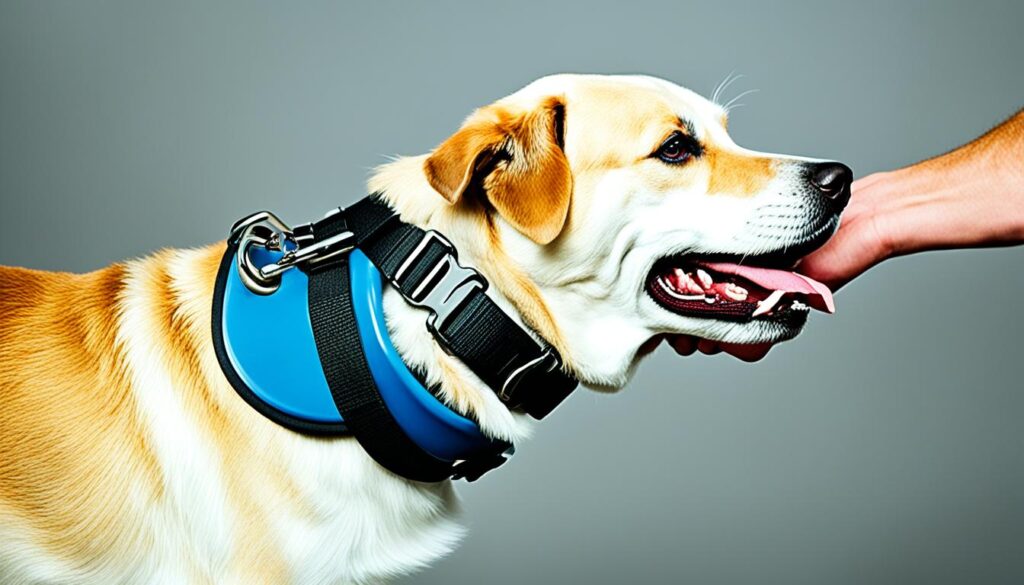When training your dog or puppy, choosing the right equipment is crucial. One of the most debated topics in the dog training community is harnesses vs collars. Both have their benefits and drawbacks, but which is better?
This article will explore the pros and cons of harnesses and collars for training your furry friend. We will discuss the factors you must consider when selecting the right equipment and analyze the effectiveness and safety of different training methods.

Key Takeaways:
- Harnesses and collars are both options for training your dog or puppy.
- Consider factors such as training goals, breed, and comfort when choosing between a harness and a collar.
- Harnesses are beneficial for reducing neck strain and providing better control during leash training.
- Collars can be effective for leash training but may pose a risk of neck injury if not used properly.
- Always prioritize the safety and comfort of your dog when selecting training equipment.
Why choose a harness over a collar for leash training?
Regarding leash training your dog, one crucial decision you’ll need is whether to use a harness or a collar. While both options have advantages, harnesses offer several benefits, making them a preferred choice for many pet owners.
Reducing the risk of neck injury with a harness
One of the primary reasons to choose a harness over a collar for leash training is the reduced risk of neck injuries, unlike collars, which put pressure on the neck and throat when a dog pulls or lunges, harnesses distribute the tension across the dog’s chest and back.
By eliminating the strain on the neck, harnesses help prevent neck injuries, such as tracheal collapse, especially in small or brachycephalic breeds prone to respiratory issues.
Improving control during leash training
Harnesses offer superior control during leash training compared to collars. The harness design gives you better leverage and control over your dog’s movements, making it easier to guide them and correct unwanted behaviors.
With a harness, you can redirect your dog’s attention and have more control when they might be tempted to pull or chase after distractions. This ultimately helps build better leash manners and promotes a positive walking experience for you and your furry friend.
Determining if a harness is the right choice for your dog’s breed
While harnesses are generally beneficial for leash training, it’s essential to consider your dog’s specific breed when deciding if a harness is the right choice. Certain breeds, such as those with short snouts or delicate necks, may benefit more from using a harness due to their physiological characteristics.
For example, French Bulldogs, Pugs, and other brachycephalic breeds have a higher risk of respiratory issues and are better suited to wearing a harness than a collar. On the other hand, some breeds with long necks and slender frames may require a collar that provides better control and prevents slipping or escaping.

When selecting a harness, consider your dog’s breed-specific needs and consult a professional trainer or veterinarian.
| Harness | Collar |
| Distributes tension across the chest and back | Places pressure on the neck and throat |
| Reduces the risk of neck injuries | Potential for neck strain and injuries |
| Provides better control and leverage | Less control during leash training |
| Suitable for breeds with flat faces or delicate necks | May be more suitable for breeds with long necks and slender frames |
Understanding the cons of dog harnesses
While dog harnesses have many advantages for leash training, it’s also essential to consider the potential downsides. In this section, we will explore two critical cons of using dog harnesses: the potential for a dog to pull more on a leash with back-clip harnesses and the importance of finding the right fit to prevent escape.
Potential for a Dog to Pull More on a Leash with Back-Clip Harnesses
As the name suggests, back-clip harnesses have a leash attachment on the back of the dog. While these harnesses can effectively distribute the pulling force more evenly across the body, they may inadvertently encourage some dogs to pull more on the leash.
When a dog pulls on a back-clip harness, the harness may enable them to exert more force and leverage, making it challenging to discourage pulling. Some dogs may interpret the pressure against the chest as a cue to push forward, leading to a pulling response.
It’s important to note that not all dogs will exhibit increased pulling behavior with back-clip harnesses. Some dogs may respond well to this type of harness and show improved leash manners.
Finding the Right Fit to Prevent Escape
Another important consideration when using a dog harness is finding the right fit to prevent escape. While harnesses provide more control and reduce strain on the neck compared to collars, it’s crucial to ensure that the harness fits properly to prevent the dog from slipping out.
Ill-fitting harnesses can pose a risk of escape, especially for small or slim dogs with a narrower body shape. If a harness is too loose, the dog may be able to wiggle out of it, resulting in a dangerous situation where the dog is flexible on a leash without any control or protection.
When selecting a dog harness, it’s essential to carefully measure your dog’s girth and follow the manufacturer’s sizing guidelines to ensure a snug and secure fit.
| Cons of Dog Harnesses | Impact |
| Potential for increased pulling | May encourage pulling behavior in some dogs |
| Risk of escape | Ill-fitting harnesses may allow dogs to slip out |
The drawbacks of using a collar for leash training
When leash training your dog, using a collar is a natural choice. However, it’s essential to understand the potential drawbacks of relying solely on a collar for training. This section will explore the negative aspects of using collars and why alternative training methods might be a better option.
Exploring how collars can cause neck strain and injuries
One of the primary concerns with using a collar for leash training is the risk of neck strain and injuries to your dog. When a dog pulls or lunges against the leash, the pressure is concentrated around the neck area, leading to discomfort and potential harm. This strain on the neck can be especially problematic for dogs with respiratory issues or neck sensitivities.
Additionally, prolonged collar use can lead to chronic neck strain, affecting your dog’s overall well-being. Neck strain can cause discomfort, pain, and long-term damage to the neck muscles and spine. Prioritizing your dog’s comfort and safety during training sessions is essential.
The risk of a choke or prong collar harming your dog
Some dog owners may use choke collars or prong collars to control their dog’s behavior during leash training. However, it’s essential to recognize the potential risks associated with these types of collars.
A choke collar tightens around the dog’s neck when tension is applied to the leash, causing discomfort or choking. This can be not only physically harmful but also emotionally distressing for your dog. Similarly, prong collars have metal prongs that can pinch or puncture the skin, causing pain and potential injury.
It is crucial to prioritize the safety and well-being of your dog during training by opting for gentle and humane training methods that focus on positive reinforcement and clear communication.

Incorporating safe training methods and alternatives to collars
Fortunately, there are safe and effective alternatives to using collars for leash training. Harnesses, for example, distribute the pressure more evenly across the dog’s body, reducing the strain on the neck and minimizing the risk of injuries. They provide better control and can help redirect pulling behaviour without causing discomfort.
Additionally, positive reinforcement training techniques, such as clicker training and reward-based methods, can be highly effective in teaching your dog proper leash manners. By focusing on positive reinforcement and clear communication, you can build a strong bond with your dog and achieve desired results without resorting to potentially harmful training devices.
When selecting dog training equipment, it is essential to prioritize your dog’s comfort, safety, and well-being. Consider consulting a professional dog trainer to determine the most suitable training methods and equipment for your dog and training goals. Remember, the key to successful leash training lies in using safe and humane methods that prioritize your dog’s happiness and welfare.
Selecting the correct type of collar for your puppy or dog
When training your puppy or dog, selecting a suitable collar is crucial. The collar you choose will impact their comfort, safety, and the effectiveness of your training sessions. This section will guide you through the options and help you make an informed decision.
Flat Collar vs Martingale Collar: What’s Better for Your Pup?
Flat collars are the most common type of collar suitable for most dogs. They consist of a simple adjustable strap that secures around your dog’s neck. These collars are great for everyday use and provide a secure attachment point for a leash.
On the other hand, martingale collars are designed for dogs who tend to pull or have necks that are larger than their heads. These collars have an additional loop that tightens when your dog pulls, preventing them from slipping out of the collar. Martingale collars provide more control and are often recommended for training purposes.
To determine which collar is better for your pup, consider their breed, size, behavior, and training goals. Flat collars may work well for small to medium-sized dogs with no pulling or escaping tendencies. On the other hand, Martingale collars are ideal for larger, strong-willed dogs or those who tend to back out of their collars.
When to Consider a Head Collar for Leash Training
Sometimes, a head collar may be a suitable option for leash training. A head collar, also known as a “Halti” or “gentle leader,” fits over your dog’s muzzle and attaches to the leash under their chin. This type of collar gives you more control over your dog’s head and redirects their attention away from pulling.
A head collar may be worth considering if your dog lunges, pulls excessively, or lacks responsiveness to other training methods. However, it’s important to note that head collars should be used as a training tool and gradually phased out once your dog has learned proper leash manners.
Choosing the suitable collar for your puppy or dog can significantly impact the success of your training efforts. Consider their needs, behavior, and training goals when deciding. Remember to prioritize your dog’s comfort and safety and the effectiveness of the training methods you employ.
Leash training tips from professional dog trainers
Regarding leash training your dog, seeking guidance from professional dog trainers is always beneficial. These experts have extensive experience teaching dogs to walk on a loose leash using harnesses and collars. By following their effective training methods, you can ensure a successful leash training journey for you and your furry friend.
Teaching a Dog to Walk on a Loose Leash Using a Harness or Collar
Professional dog trainers emphasize the importance of teaching dogs to walk on a loose leash, which promotes comfort and control during walks. Here are some leash training tips:
- Please start with the right equipment: Whether you choose a harness or a collar, ensure that it fits properly and is comfortable for your dog. This will make the training process more effective.
- Use positive reinforcement: Reward your dog with treats or praise when they walk calmly by your side. This positive reinforcement encourages them to continue exhibiting the desired behavior.
- Practice loose leash walking: Begin walking in a quiet area with minimal distractions. Hold the leash loosely and walk steadily, encouraging your dog to stay close to you without pulling.
- Use redirection techniques: If your dog starts to pull on the leash, gently change direction and encourage them to follow. This reinforces the idea that stretching won’t get them where they want to go.
- Be patient and consistent: Leash training takes time and repetition. Stay patient and consistent with your training sessions, reinforcing positive behaviors and redirecting unwanted ones.
Remember, each dog is unique, and their response to leash training may vary. Be adaptable and tailor the training methods to suit your dog’s needs.
How to Transition from a Collar to a Harness for Better Training Results
If you’ve been using a collar for leash training and want to transition to a harness, follow these steps to ensure a smooth and successful switch:
- Introduce the harness gradually: Allow your dog to become familiar with it by introducing it positively and progressively. Start by placing it near your dog during training sessions, then slowly move on to having them wear it for short periods.
- Associate the harness with positive experiences: Use treats, praise, and play to create positive associations with the harness. This will help your dog see it as something enjoyable and rewarding.
- Practice walking on a loose leash: Once your dog is comfortable wearing the harness, practice loose leash walking using the same techniques mentioned earlier. Encourage your dog to walk on a loose leash and reward them for cooperation.
- Gradually decrease reliance on the collar: As your dog becomes more accustomed to the harness, gradually reduce the dependence on the collar. Start by attaching the leash to the collar and the harness, then slowly transition to using only the harness for leash attachment.
Following these steps and remaining patient and consistent, you can effectively transition from a collar to a harness for better leash training results.
What to look for when purchasing a dog harness or collar
When it comes to purchasing a dog harness or collar, a few key considerations can make a big difference in the comfort, safety, and effectiveness of training your furry friend. Here, we will explore the importance of adjustability and fit and choose the suitable material for durability and comfort.
Adjustability and Fit: Key Considerations
One of the most important factors to consider when purchasing a dog harness or collar is the adjustability and fit. A properly fitting harness or collar ensures a secure and comfortable training experience for your dog. Look for adjustable straps to customize the fit to your dog’s specific measurements. This will prevent the harness or collar from being too tight, which could cause discomfort, restrict movement, or be too loose, which may result in slipping or escape.
Additionally, consider the design of the harness or collar. Look for features like multiple adjustment points or buckles that allow for a more precise and secure fit. This will ensure that the harness or collar matches your dog’s body shape, providing an optimal fit and preventing any discomfort or chafing during training sessions.
The Importance of Choosing the Right Material for Comfort and Durability
When selecting a dog harness or collar, choosing a suitable material for comfort and durability is crucial. Look for soft, breathable, and non-irritating materials for your dog’s skin. A comfortable harness or collar will make your dog more likely to cooperate during training sessions, ensuring a positive experience for both of you.
In addition to comfort, durability is also essential. Opt for solid and long-lasting materials to withstand training activities and regular use. A durable harness or collar will save you money in the long run by not having to replace worn-out equipment frequently.
Consider the specific needs and preferences of your dog when choosing the material. Some dogs may have allergies or sensitivities to certain fabrics, so it’s essential to select a hypoallergenic material suitable for their needs.
By considering adjustability and fit and choosing the suitable material, you can ensure that the dog harness or collar you purchase provides a comfortable and secure fit for your furry friend. This will contribute to safe and effective training sessions, creating a positive and enjoyable experience for you and your dog.
Conclusion
Choosing the right equipment for leash training your dog or puppy is crucial for their safety and practical training. After exploring the debate between harnesses and collars, it is clear that both options have their advantages and drawbacks.
Regarding harnesses, they offer benefits such as reducing the risk of neck injuries and providing better control during leash training. However, it’s essential to consider the potential for increased pulling on the leash with back-clip harnesses and ensuring a proper fit to prevent escape.
On the other hand, collars may cause neck strain and injuries, but there are alternatives to traditional collars, like martingale collars and head collars. It’s crucial to prioritize the comfort and safety of your dog during training.
In conclusion, there is no one-size-fits-all answer to the harness vs collar debate. The perfect choice depends on your dog’s breed, training goals, and personal preferences. It’s always recommended to consult with professional trainers to determine the most suitable option for your furry companion.
FAQs
Q: Should I choose a dog collar or a harness for leash training?
A: Many experts recommend using a harness instead of a collar for leash training. A harness can give you more control and is safer for your dog, as it distributes the pressure across a broader area of their body. This is particularly important for dogs that pull, as collars can put dangerous pressure on the neck. Harnesses are also great for small dogs and dogs with breathing issues.
Q: What are the cons of dog collars during leash training?
A: The cons of dog collars, mainly when used for leash training, include the potential for neck injuries, choking, and strain on your dog’s throat, particularly for breeds prone to breathing problems. Collars can also slip off if not fitted properly, posing a risk if your dog gets loose. Collars can exacerbate pulling behavior for persistent pullers, making walks less enjoyable.
Q: Are harnesses suitable for all dogs?
A: Yes, harnesses suit most dogs, from small to large breeds. The key is finding the right type and size for your pet. There are main dog harnesses, such as front-clip, no-pull, and body harnesses, each designed with different dog behavior and training needs. It’s better to consult with a pet professional if you need clarification on which type would be suitable for your dog.
Q: Can training with a collar adversely affect my dog’s behavior?
A: Yes, training with a collar, especially with methods that rely on correction, like slip collars, choke collars, and prong collars, can have adverse effects on dog behaviour. They can increase anxiety and aggression in many dogs, leading to unwanted behaviours rather than curbing them.
Q: How do I ensure my dog’s safety using a harness or collar?
A: Whether using a collar or harness, ensuring it fits your dog correctly is vital to keeping your dog safe. A good harness or collar should be snug but not tight, allowing you to do two fingers between the gear and your dog’s body. Regularly check for signs of wear and tear and replace it if necessary. For collars, ensure the ID tags are always up to date, and for harnesses, opt for models with reflective materials if you’re walking your dog at night.
Q: What’s better for a service dog, a collar or a harness?
A: A harness is often preferred for service dogs because it offers better control and distributes pressure more evenly, which is essential considering the extensive periods they may be working and walking. Harnesses can also carry special patches or signs that identify the dog as a service animal, making it clear to others that the dog is working and should not be disturbed.
Q: How can I effectively teach my dog to walk on a leash without pulling?
A: Teaching your dog to walk on a leash without pulling requires consistency, patience, and the right equipment. A no-pull harness is an excellent tool, as it discourages pulling by redirecting your dog’s movement. Combine the use of a no-pull harness with positive reinforcement techniques, like treats and praise, to encourage good behavior.
Q: Are there any types of collars that are safer than others?
A: Yes, if you prefer to use a collar, rolled collars are generally safer than flat collars for long-haired breeds, as they are less likely to cause matting around the neck. Breakaway collars, which can quickly come undone if caught, offer a safer option for dogs that might get tangled while exploring. Ultimately, the safety of a collar also depends on using it responsibly and never using it to inflict pain or discomfort on your dog.

